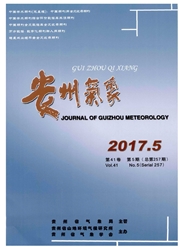

 中文摘要:
中文摘要:
利用福建省漳州市10个气象站1962—2012年1、2、12月逐日最低气温资料,分析漳州极端最低气温变化特征。结果表明:①漳州多年冬季平均极端最低气温以0.397℃/10 a线性倾向率增加。②各年代际气候倾向率差异明显,20世纪80年代年极端最低气温增加最快(气候倾向率2.715℃/10 a),21世纪以来气候倾向率最小(0.006℃/10 a),20世纪70年代内极端最低气温变化相对稳定(变异系数为0.85),20世纪90年代气温变化剧烈(变异系数为1.72)。③极端最低气温(〈5℃)日数以-1.6℃/10 a的气候倾向率减少,多年低温日数平均值为7.5 d。④漳州市区、郊区极端最低气温显著增加,漳州市区极端最低气温以0.546℃/10 a气候倾向率增加,郊区以0.381℃/10 a气候倾向率增加。⑤漳州市区与郊区极端最低气温(〈5℃)日数平均差值5 d,市区低温日数以-2.427 d/10 a的气候倾向率减小,郊区低温日数以-1.509 d/10 a的气候倾向率减少。
 英文摘要:
英文摘要:
Based on the data of daily lowest temperature from 10 stations in Zhangzhou Fujian province during winter of year 1962 to 2012,the study mainly analyzed characteristics of extremely low temperature change. The result showed:①the perennial mean extremely low temperature in Zhangzhou increased in linear tendency of 0. 397℃ /10 a. ②The decadal variability of climate tendency rate was significant,and the annual lowest temperature in1980 s went up fastest( climate tendency rate of 2. 715 ℃ /10 a),while slowest in 21 st century( climate tendency rate of 0. 006 ℃ /10 a). And it was relatively stable in 1970s(Coefficient of variation of 0. 85.),While it turned out to be a sharp change in 1990s(Coefficient of variation of 1. 72). ③The days with extremely low temperature( 〈5 ℃) decreased by- 1. 6 ℃ /10 a and the perennial mean of days with low temperature was 7. 5 d. ④The extremely low temperature in urban and suburban areas increased significantly,among which urban areas went up by the tendency of 0. 546 ℃ /10 a versus 0. 381 ℃ /10a in suburban areas. ⑤The average D- value of days with extremely low temperature between urban and suburban areas was 5 d,which was relevant to the process of urbanization in Zhangzhou,and the days of low temperature in urban areas decreased by- 2. 247 d /10 a versus- 1. 509 d /10a in suburban area.
 同期刊论文项目
同期刊论文项目
 同项目期刊论文
同项目期刊论文
 期刊信息
期刊信息
